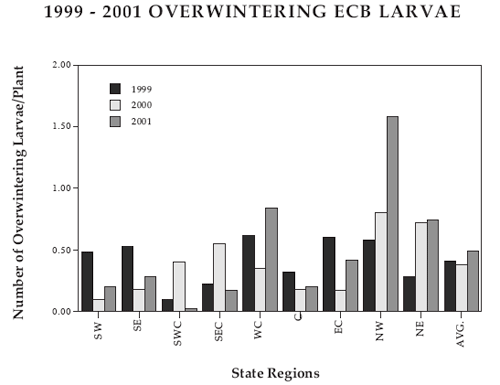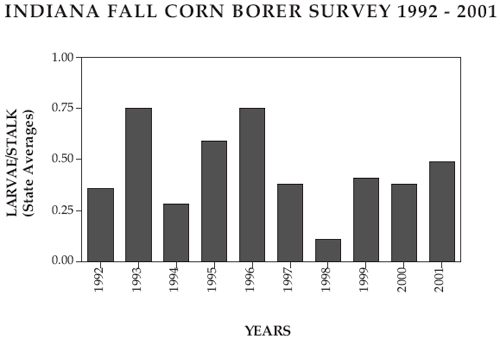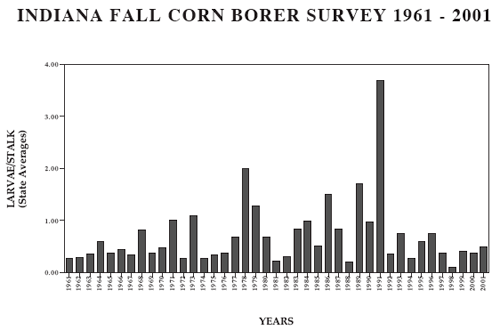Pest & Crop Newsletter
|
||||||||||
Survey of Overwintering European Corn Borer and Management Considerations for 2002– (John Obermeyer, Rich Edwards, and Larry Bledsoe)
Ron Blackwell’s survey of overwintering European corn borer (ECB) is complete and statewide corn borer numbers are somewhat higher than those observed over the last five years (see accompanying graphs and table). However, compared to 41 years of survey data, 2001’s overwintering population is about average. Breaking the numbers down by state regions show that higher numbers of stalk cavities and borers are present in northwestern and west central counties. What does this mean for 2002? ECB larvae now either nestled in crop residue or in the stalks of yet to be harvested corn form the bulk of next year’s threat to Indiana corn. However, environmental factors during the growing season, more than anything else, will determine whether this insect becomes an economic threat in 2002. Entomologists are cautious when making predictions since it is very difficult to accurately predict if an insect such as ECB will reach its biotic potential. Under optimal conditions, each female moth can produce over 400 eggs spread in masses among many plants and fields! What about using Bt corn for 2002? A major drawback with using this excellent pest management technology is that producers must anticipate economic corn borer damage before the corn crop is even planted. As stated above, the previous year’s infestations and overwintering survey information won’t accurately predict next year’s population and damage. Therefore, in order to benefit from using Bt corn, it is best to assess the potential field risk to ECB moth attraction, egg laying, and subsequent larval damage. First brood females are generally attracted to the tallest, greenest corn for egg laying – normally early-planted corn. This, coupled with conventionally tilled, and rotated fields and adequate soil fertility levels increases the risk of first generation attack. Many producers traditionally plant certain fields first, e.g., fields close to the farmstead, well drained fields, etc. If these fields are expected to be ahead in their growth and development compared to neighboring corn the first week in June, then there is a greater likelihood of return on investment in Bt corn. Predicting second, or even third generation populations and damage is impossible due to an extensive list of variables. Our advantage when dealing with second generation ECB is that we understand the pest’s behavior enough to know that these later flights are attracted to actively pollinating corn – thus late-planted or late-maturing corn. For late-planted fields, the investment in Bt corn could pay good returns. Producers who grow Bt corn must implement a resistance management program that includes the planting of a corn borer refuge(s) of non-Bt corn. Refuges should be planted within a half-mile (0.5) of Bt corn at approximately the same time and with a similar maturity corn. Academic, industry, and producer organizations support the EPA requirement of a 20% refuge for the 2002 growing season. Neighbors planting non-Bt corn cannot be considered as providing the refuge for another producer. Without these refuges, which preserve genetic diversity of the corn borer population, this technology will likely be short lived. More specific information on resistance management is available from seed company agronomists. As many of you know, Bt corn is presently under review by EPA. A similar review for Bt cotton has just been completed and the technology has received reregistration. Apparently the monarch caterpillar situation is being thoroughly investigated before a final decision on reregistration of Bt corn is made. Because many recent scientific studies have been favorable toward the positive co-habitation of monarch caterpillars and Bt corn, reregistration of Bt corn is expected any time. It is anticipated that the refuge management plan will also stay the same. However, it would be a good idea to obtain confirmation of this before making 2002 planting decisions.
European Corn Borer Survey Results, Fall 2001
|
||||||||||
Welcome to a New Extension Specialist in Plant Pathology at Purdue University– (Gregory Shaner)
A new faculty member has joined the Department of Botany and Plant Pathology at Purdue. Dr. Andreas Westphal joined the department in the middle of September as an assistant professor with research and extension responsibilities. Andreas will have research responsibility in soil-borne diseases of major crops in Indiana. In his extension efforts he will work with Greg Shaner on diseases of field crops, with emphasis on soil-borne diseases. Andreas will participate in the Crop Diagnostic Training program, the activities of the Plant & Pest Diagnostic Laboratory, and winter meetings. Andreas is a native of Germany. After his apprenticeship for farming, he received his B.Sc. and M.Sc. from the University of Göttingen, Germany, the latter for working on leaf diseases of barley. He then moved to southern California to conduct his studies at the University of California, Riverside. He received his Ph.D. in 1998 from after completion of his dissertation on soil suppressiveness against the sugar beet cyst nematode. He then took a position as a postdoctoral researcher at the University of California, Davis on the replant problem of grape and peach. In October 1999, he accepted an Assistant Professor/Extension Plant Pathologist position with Texas A&M University at the Research and Extension center at Weslaco to provide plant pathology expertise for crops and ornamentals in the subtropical environment. Focus of his program was on soil-borne diseases of cotton and soybean as well as diseases of sugarcane and cucurbit crops. Andreas’ program at Purdue will include soil-borne diseases of soybean and watermelon.
|
||||||||||
Transgenic Corn Harvest Reminders– (Bob Nielsen, and Dirk Maier, Ag. & Biological Engineering Dept.) NOTE: This article includes recommendations from a longer one originally published earlier this year (P&C Newsletter, 23 March 2001) and available on the Web as an Adobe Acrobat formatted publication at <http://www.agcom.purdue.edu/AgCom/Pubs/GQ/GQ-46.pdf>. Minor modifications have been made on this article. Because certain transgenic corn hybrids (most notably glyphosate tolerant hybrids) are still not yet approved for overseas sales to the European Union, it is vitally important that growers of such hybrids remain keenly aware of the needs to a) segregate this grain and b) market it to approved end use channels. Segregation of transgenic and non-transgenic corn grain is also important for those growers who will market grain to certain grain processors that will not accept transgenic grain. Also recognize that grain elevators would prefer not to accept any transgenic corn that does not have full approval for the global market place and, subsequently, may change their stance on acceptance of such grain this fall. Remember that glyphosate tolerant corn hybrids are approved only in the U.S. and Japan, but not elsewhere around the globe. Two transgene events currently exist for this trait, GA21 (original) and NK603 (more recent). Of the two, the GA21 transgene event is the predominant one used in glyphosate tolerant corn grown commercially by farmers in 2001. While a quick test kit for the detection of the newer NK603 event was recently announced by Strategic Diagnostics, Inc. (SDI) on 8 Oct 2001, no quick test kits currently exist for the more prevalent GA21 transgene event in corn (personal communication with SDI, 10 Oct 2001) and no tolerance levels have been established for either event. Even though some grain buyers are assuring farmers that they will purchase grain from these hybrids, farmers bear the sole risk for rejection at the first point of sale should buying policies change at any time in the future. Harvest Operation. Combines should be super cleaned prior to the start of grain harvest to minimize the risk of any leftover grain from 2000 in the machine. If non-transgenic and transgenic varieties are grown on the same farm, then the sequence of harvesting those fields should follow the FIF-FOF (First-In-Field, First-Off-Field) principle. This means that non-transgenic varieties planted in the field first should be harvested before transgenic ones to avoid transgenic grain commingling with non-transgenic grain from the nooks and crannies of the combine. Additionally, where transgenic and non-transgenic fields border each other, growers should strive to harvest areas of non-transgenic fields located within about 660 feet from the adjacent transgenic field and segregate the grain from that harvested from the remainder of the non-transgenic field in recognition of the possibility for pollen drift contamination from the adjacent transgenic field. The recommended 660 feet buffer zone is that typically used by the seed industry for minimizing contamination of seed production fields. This buffer zone distance includes any non-cropland (roadways, ditches) that may separate two fields and is especially appropriate for non-transgenic fields that lie to the east or north of transgenic fields because of the usual prevailing winds in Indiana during pollination. If growers are certain that adjacent fields were NOT pollinating at the same time, then the buffer zone may not be necessary. Handling, Storage & Transport. All grain transport vehicles (trucks, wagons, trailers, grain carts), all grain handling equipment (augers, legs, pits, wet holding bins, dryers) and all grain storage facilities should be super cleaned prior to the start of grain harvest. By following the FIF-FOF principle during harvesting, the post-harvest operations will benefit because non-transgenic varieties can be received, dried and transferred to storage ahead of transgenic varieties. Obviously, transgenic and non-transgenic grain should be stored separately on-farm to avoid grain commingling, and to take advantage of potential premiums for identity-preserved grains in the market place. Assuming that transgenic grain was put into storage last, then emptying storage facilities for transport to market should begin with the transgenic grain in order to avoid an extra cleaning step, and thus, reduce the chance of contamination. However, given that this strategy will depend on a farmer’s marketing plan, all grain transport vehicles and grain handling equipment should be super cleaned prior to every time that non-transgenic grain load-out follows transgenic load-out in order to avoid commingling of grain leftover from the previous handling operation. Grain Channeling. Be aware that Monsanto has established a channeling program for glyphosate tolerant corn. When buying glyphosate tolerant corn seed, farmers commit in writing to market the grain from these hybrids only through approved channels. We urge all farmers to live up to this commitment! Approved channels include:
Over 2000 U.S. elevators are willing to buy non-EU approved grains. The American Seed Trade Association (ASTA) maintains an online database of “… grain handling facilities that have indicated a willingness to purchase, receive, and handle genetically enhanced corn products that have full U.S. registration for food and feed use, but are not yet approved for import into the European Union.” The Web address for the ASTA database is <http://asta.farmprogress.com/>. Be aware that Monsanto, as part of their channeling program, is also establishing a database of every farmer who purchases glyphosate tolerant corn seed. Although they have committed not to reveal names and addresses, they will work with any inquiring processor and reveal to them how many acres of glyphosate tolerant corn were planted in the areas from where they plan to purchase corn. For any area that a processor raises concern, Monsanto will contact those farmers and remind them to market their corn only through approved channels after harvest. We urge processors to inquire about glyphosate tolerant acres and urge all farmers to comply with the channeling program! References: American Seed Trade Association. December 2000. Grain Handlers Database. On the Web at: <http://asta.farmprogress.com/> (URL verified 13 Sep 2001) Iowa Grain Quality Initiative. 2001. GMO Grain Testing Directory. On the Web at: <http://www.extension.iastate.edu/Pages/grain/publications/testing/testingcos.html> (URL verified 13 Sep 2001) Monsanto Company. 2000. Grain Channeling Information. On the Web at: <http://www.farmsource.com/Product_Info/GrainChannel.html> (URL verified 13 Sep 2001) Nielsen, Bob and Dirk Maier. 2001. GMO Issues Facing Indiana Farmers in 2001. Purdue Univ. Cooperative Extension Service Publication GQ-46. On the Web at: <http://www.agcom.purdue.edu/AgCom/Pubs/GQ/GQ-46.pdf> (URL verified 13 Sep 2001) Wiebold, B. 14 Sep 2001. Segregated Marketing of Grain from Glyphosate Tolerant Corn. Integrated Pest & Crop Management Newsletter. University of Missouri-Columbia . On the Web at: <http://ipm.missouri.edu/ipcm/archives/v11n22/ipmltr1.htm> (URL verified 13 Sep 2001)
|
||||||||||
New Field Crops Web Site - Below is a view of our new Field Crops IPM web site main page. We hope you will find this site easy to navigate and locate all the field crop pest information that you are seeking. This site will always be evolving, bookmark it as more information will be added. We would be glad to hear your comments! http://www.entm.purdue.edu/entomology/ext/fieldcropsipm/main.html
Hands-on Post Harvest Training and Recertification Workshop – (Linda Mason)–
|








